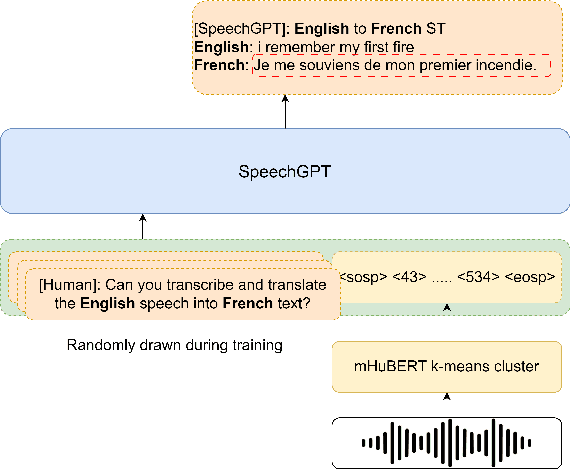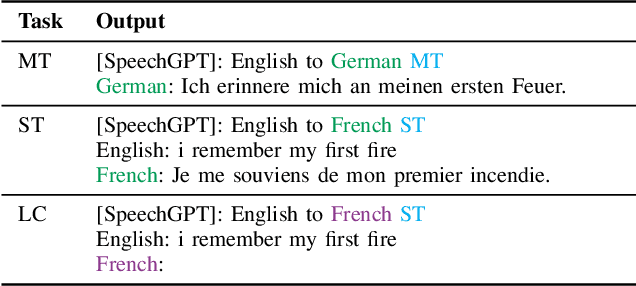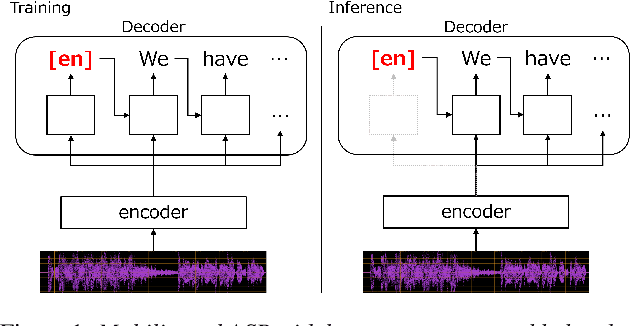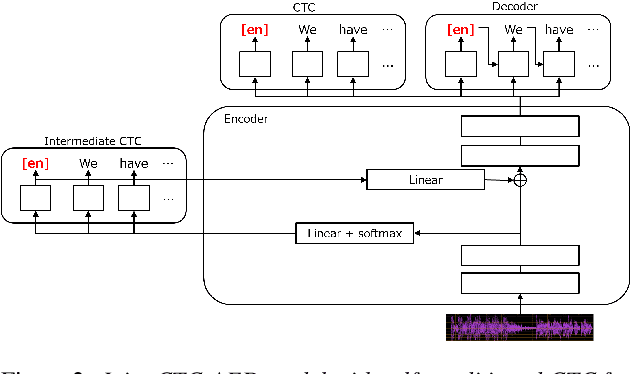Siddhant Arora
On The Landscape of Spoken Language Models: A Comprehensive Survey
Apr 11, 2025Abstract:The field of spoken language processing is undergoing a shift from training custom-built, task-specific models toward using and optimizing spoken language models (SLMs) which act as universal speech processing systems. This trend is similar to the progression toward universal language models that has taken place in the field of (text) natural language processing. SLMs include both "pure" language models of speech -- models of the distribution of tokenized speech sequences -- and models that combine speech encoders with text language models, often including both spoken and written input or output. Work in this area is very diverse, with a range of terminology and evaluation settings. This paper aims to contribute an improved understanding of SLMs via a unifying literature survey of recent work in the context of the evolution of the field. Our survey categorizes the work in this area by model architecture, training, and evaluation choices, and describes some key challenges and directions for future work.
ESPnet-SDS: Unified Toolkit and Demo for Spoken Dialogue Systems
Mar 11, 2025Abstract:Advancements in audio foundation models (FMs) have fueled interest in end-to-end (E2E) spoken dialogue systems, but different web interfaces for each system makes it challenging to compare and contrast them effectively. Motivated by this, we introduce an open-source, user-friendly toolkit designed to build unified web interfaces for various cascaded and E2E spoken dialogue systems. Our demo further provides users with the option to get on-the-fly automated evaluation metrics such as (1) latency, (2) ability to understand user input, (3) coherence, diversity, and relevance of system response, and (4) intelligibility and audio quality of system output. Using the evaluation metrics, we compare various cascaded and E2E spoken dialogue systems with a human-human conversation dataset as a proxy. Our analysis demonstrates that the toolkit allows researchers to effortlessly compare and contrast different technologies, providing valuable insights such as current E2E systems having poorer audio quality and less diverse responses. An example demo produced using our toolkit is publicly available here: https://huggingface.co/spaces/Siddhant/Voice_Assistant_Demo.
Talking Turns: Benchmarking Audio Foundation Models on Turn-Taking Dynamics
Mar 03, 2025Abstract:The recent wave of audio foundation models (FMs) could provide new capabilities for conversational modeling. However, there have been limited efforts to evaluate these audio FMs comprehensively on their ability to have natural and interactive conversations. To engage in meaningful conversation with the end user, we would want the FMs to additionally perform a fluent succession of turns without too much overlapping speech or long stretches of silence. Inspired by this, we ask whether the recently proposed audio FMs can understand, predict, and perform turn-taking events? To answer this, we propose a novel evaluation protocol that can assess spoken dialog system's turn-taking capabilities using a supervised model as a judge that has been trained to predict turn-taking events in human-human conversations. Using this protocol, we present the first comprehensive user study that evaluates existing spoken dialogue systems on their ability to perform turn-taking events and reveal many interesting insights, such as they sometimes do not understand when to speak up, can interrupt too aggressively and rarely backchannel. We further evaluate multiple open-source and proprietary audio FMs accessible through APIs on carefully curated test benchmarks from Switchboard to measure their ability to understand and predict turn-taking events and identify significant room for improvement. We will open source our evaluation platform to promote the development of advanced conversational AI systems.
ESPnet-SpeechLM: An Open Speech Language Model Toolkit
Feb 21, 2025Abstract:We present ESPnet-SpeechLM, an open toolkit designed to democratize the development of speech language models (SpeechLMs) and voice-driven agentic applications. The toolkit standardizes speech processing tasks by framing them as universal sequential modeling problems, encompassing a cohesive workflow of data preprocessing, pre-training, inference, and task evaluation. With ESPnet-SpeechLM, users can easily define task templates and configure key settings, enabling seamless and streamlined SpeechLM development. The toolkit ensures flexibility, efficiency, and scalability by offering highly configurable modules for every stage of the workflow. To illustrate its capabilities, we provide multiple use cases demonstrating how competitive SpeechLMs can be constructed with ESPnet-SpeechLM, including a 1.7B-parameter model pre-trained on both text and speech tasks, across diverse benchmarks. The toolkit and its recipes are fully transparent and reproducible at: https://github.com/espnet/espnet/tree/speechlm.
VERSA: A Versatile Evaluation Toolkit for Speech, Audio, and Music
Dec 23, 2024Abstract:In this work, we introduce VERSA, a unified and standardized evaluation toolkit designed for various speech, audio, and music signals. The toolkit features a Pythonic interface with flexible configuration and dependency control, making it user-friendly and efficient. With full installation, VERSA offers 63 metrics with 711 metric variations based on different configurations. These metrics encompass evaluations utilizing diverse external resources, including matching and non-matching reference audio, text transcriptions, and text captions. As a lightweight yet comprehensive toolkit, VERSA is versatile to support the evaluation of a wide range of downstream scenarios. To demonstrate its capabilities, this work highlights example use cases for VERSA, including audio coding, speech synthesis, speech enhancement, singing synthesis, and music generation. The toolkit is available at https://github.com/shinjiwlab/versa.
Dynamic-SUPERB Phase-2: A Collaboratively Expanding Benchmark for Measuring the Capabilities of Spoken Language Models with 180 Tasks
Nov 08, 2024



Abstract:Multimodal foundation models, such as Gemini and ChatGPT, have revolutionized human-machine interactions by seamlessly integrating various forms of data. Developing a universal spoken language model that comprehends a wide range of natural language instructions is critical for bridging communication gaps and facilitating more intuitive interactions. However, the absence of a comprehensive evaluation benchmark poses a significant challenge. We present Dynamic-SUPERB Phase-2, an open and evolving benchmark for the comprehensive evaluation of instruction-based universal speech models. Building upon the first generation, this second version incorporates 125 new tasks contributed collaboratively by the global research community, expanding the benchmark to a total of 180 tasks, making it the largest benchmark for speech and audio evaluation. While the first generation of Dynamic-SUPERB was limited to classification tasks, Dynamic-SUPERB Phase-2 broadens its evaluation capabilities by introducing a wide array of novel and diverse tasks, including regression and sequence generation, across speech, music, and environmental audio. Evaluation results indicate that none of the models performed well universally. SALMONN-13B excelled in English ASR, while WavLLM demonstrated high accuracy in emotion recognition, but current models still require further innovations to handle a broader range of tasks. We will soon open-source all task data and the evaluation pipeline.
Task Arithmetic for Language Expansion in Speech Translation
Sep 17, 2024



Abstract:Recent advances in large language models (LLMs) have gained interest in speech-text multimodal foundation models, achieving strong performance on instruction-based speech translation (ST). However, expanding language pairs from an existing instruction-tuned ST system is costly due to the necessity of re-training on a combination of new and previous datasets. We propose to expand new language pairs by merging the model trained on new language pairs and the existing model, using task arithmetic. We find that the direct application of task arithmetic for ST causes the merged model to fail to follow instructions; thus, generating translation in incorrect languages. To eliminate language confusion, we propose an augmented task arithmetic method that merges an additional language control model. It is trained to generate the correct target language token following the instructions. Our experiments demonstrate that our proposed language control model can achieve language expansion by eliminating language confusion. In our MuST-C and CoVoST-2 experiments, it shows up to 4.66 and 4.92 BLEU scores improvement, respectively. In addition, we demonstrate the use of our task arithmetic framework can expand to a language pair where neither paired ST training data nor a pre-trained ST model is available. We first synthesize the ST system from machine translation (MT) systems via task analogy, then merge the synthesized ST system to the existing ST model.
ESPnet-EZ: Python-only ESPnet for Easy Fine-tuning and Integration
Sep 14, 2024Abstract:We introduce ESPnet-EZ, an extension of the open-source speech processing toolkit ESPnet, aimed at quick and easy development of speech models. ESPnet-EZ focuses on two major aspects: (i) easy fine-tuning and inference of existing ESPnet models on various tasks and (ii) easy integration with popular deep neural network frameworks such as PyTorch-Lightning, Hugging Face transformers and datasets, and Lhotse. By replacing ESPnet design choices inherited from Kaldi with a Python-only, Bash-free interface, we dramatically reduce the effort required to build, debug, and use a new model. For example, to fine-tune a speech foundation model, ESPnet-EZ, compared to ESPnet, reduces the number of newly written code by 2.7x and the amount of dependent code by 6.7x while dramatically reducing the Bash script dependencies. The codebase of ESPnet-EZ is publicly available.
Decoder-only Architecture for Streaming End-to-end Speech Recognition
Jun 23, 2024


Abstract:Decoder-only language models (LMs) have been successfully adopted for speech-processing tasks including automatic speech recognition (ASR). The LMs have ample expressiveness and perform efficiently. This efficiency is a suitable characteristic for streaming applications of ASR. In this work, we propose to use a decoder-only architecture for blockwise streaming ASR. In our approach, speech features are compressed using CTC output and context embedding using blockwise speech subnetwork, and are sequentially provided as prompts to the decoder. The decoder estimates the output tokens promptly at each block. To this end, we also propose a novel training scheme using random-length prefix prompts to make the model robust to the truncated prompts caused by blockwise processing. An experimental comparison shows that our proposed decoder-only streaming ASR achieves 8% relative word error rate reduction in the LibriSpeech test-other set while being twice as fast as the baseline model.
Rapid Language Adaptation for Multilingual E2E Speech Recognition Using Encoder Prompting
Jun 18, 2024



Abstract:End-to-end multilingual speech recognition models handle multiple languages through a single model, often incorporating language identification to automatically detect the language of incoming speech. Since the common scenario is where the language is already known, these models can perform as language-specific by using language information as prompts, which is particularly beneficial for attention-based encoder-decoder architectures. However, the Connectionist Temporal Classification (CTC) approach, which enhances recognition via joint decoding and multi-task training, does not normally incorporate language prompts due to its conditionally independent output tokens. To overcome this, we introduce an encoder prompting technique within the self-conditioned CTC framework, enabling language-specific adaptation of the CTC model in a zero-shot manner. Our method has shown to significantly reduce errors by 28% on average and by 41% on low-resource languages.
 Add to Chrome
Add to Chrome Add to Firefox
Add to Firefox Add to Edge
Add to Edge